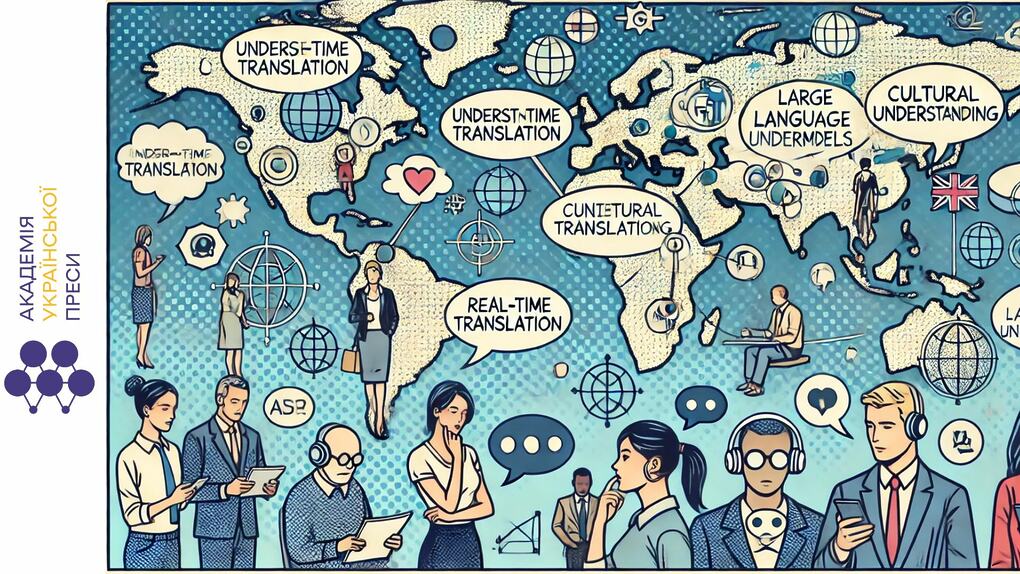
This is the third blog where we discuss the possibilities of language models (LLMs), and this time we are looking at translation and contextual understanding with their help. You can read the first and second blogs on the resources of the Academy of Ukrainian Press.
Content:
Whenever we try to talk to people from another part of the world, an invisible barrier arises - the language context. It is difficult to explain in words, but easy to feel. Because communication is not just a set of words. Its meanings take on different shades in different cultural and emotional circumstances. And all these shades change the way we perceive phrases and meanings, understand and evaluate what we hear.
Traditional translation methods, to be honest, tackled the task like an elephant on ice skates (when was the last time anyone opened a printed dictionary to find the right translation?). However, the advent of large language models has slowly been teaching this elephant not just to skate, but to play hockey. Now words are not just translated - language models understand the meaning, delve into the context, which sometimes remains a stumbling block for them, but no longer one that cannot be avoided.
What is interesting about LLM translation?
This is because when translating, they try not just to replace one word with another, but to understand why we say things the way we do. They are “learning” the language environment, and this makes them somewhat similar to humans in communication (oh, those chats where you can talk about everything with a “smart” person), although at a very early stage.
Their ability to “learn” the nuances of languages based on huge amounts of text from different sources allows them to translate with a deeper understanding. By processing trillions of words, they build up a vast knowledge of language structure, subtleties of meaning, communication styles, and how certain phrases can evoke an emotional response.
They can distinguish between "common phrases" and "emotional undertones," attempting to combine words in ways that give sentences their intended meaning. And let’s not even start on their attempts to joke or understand sarcasm in queries — something once considered the exclusive domain of human intelligence.
The true value of LLMs, however, lies in their ability to go beyond merely replicating existing patterns; they process information and can "read between the lines." For instance, the phrase "Black Monday" might refer to a financial crisis or simply a bad day. The task of an LLM is to grasp the meaning most relevant to the given context and culture and present it accordingly.
Another important ability of language models is the so-called “erasure” of cultural differences during translation. Imagine you're at an international meeting with colleagues where everyone speaks their native language or English, and you usually rely on your own language skills or on the qualifications of a translator. But LLMs change this: they don't just translate phrases, they make them equally understandable to everyone, as if all participants belong to the same cultural environment. And the process takes place in real time.
Thanks to their algorithms, the models choose not just accurate translations, but the most appropriate analogues that help to erase language differences. For example, LLM automatically adapts a familiar phrase from Ukrainian culture to the American context, preserving the meaning and avoiding explanations that were previously simply necessary. This makes communication smooth and natural, allowing you to focus on the essence of the conversation without unnecessary distractions.
Time to forget about learning languages?
Language models, like the “universal translator” from science fiction movies, make you wonder whether it's worth spending time learning other languages if you can quickly master the principles of LLM? After all, as soon as you understand how to build a request or edit a phrase for clarity, the model will give you a translation that takes into account the context, emotional coloring, and, of course, observes language features. Even if you are not sure whether you are expressing the idea correctly.
Students often ask me: “The model thinks in Ukrainian, doesn't it?”
But in fact, no, LLM does not “think” in Ukrainian or any other language. It analyzes billions of text samples to “understand” how people speak a particular language, but it does not have full conscious understanding. It builds translations based on statistical analysis, so it is sometimes impressive how accurately it chooses words.
However, this technology has one significant advantage: with an LLM, anyone can become a polyglot without opening a single textbook. And while learning languages still has its advantages for a deeper understanding of cultures and self-expression, in practice, many people choose an easier path.
Questions and answers
Language models such as LLM use extensive datasets to train, allowing them to understand the deeper nuances of language and the context in which words are used. These models analyze language patterns and structures on a scale that traditional methods cannot, resulting in greater accuracy in understanding and translating texts.
LLMs “learn” from texts from different cultures, which allows them to identify and adapt cultural nuances and emotional colors in their translations. This means that they can distinguish when the same words or phrases have different meanings in different cultural contexts.
Although LLMs can greatly simplify the translation process, they cannot completely replace language learning. Learning a language gives you a deeper understanding of a culture, allows you to establish intercultural connections and develop skills that an LLM cannot reproduce. Thus, despite the great possibilities of the LLM, traditional language learning is still considered valuable and irreplaceable.
#LLM